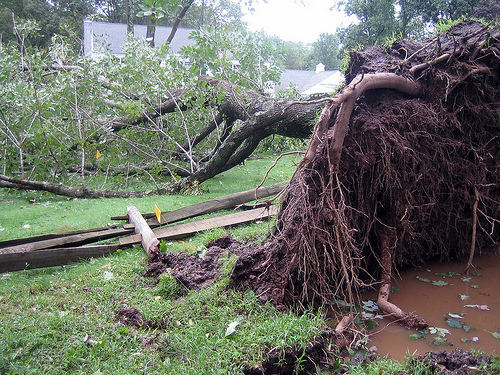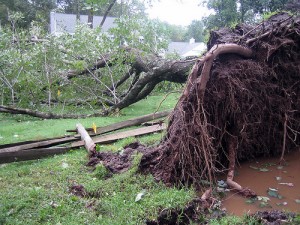Uprooted

By Viki Volk
Publisher
That word ‘rooted’ doesn’t hold quite the same meaning lately. Not around these parts, where 50 year old trees toppled by the hundreds. Prodded by Hurricane Irene, thousands of trees uprooted a goodly slug of this peninsula of clay and marsh.
Speculation abounds. Why only trees? Hurricane Irene didn’t take so many shingles or pieces of siding. And although she flooded some engines, she didn’t leave cars overturned in her wake. She left blankets of whole trees, felled, not ripped apart, broken only in the falling.
Wind seems an unlikely solo culprit. Why not more siding and toppled cars? Was it the earthquake loosening the roots? California seismologists say no. Certainly the rain saturating the ground followed by the wind and more rain, but there was a final collaborator. Gravity.
Get over any misconception that branches and roots are roughly the same size. No way. Tree roots are shallow and grow laterally mostly in the top foot of the soil, often within the first six to eight inches. Virtually all trees begin life with a strong vertical tap root growing downward but “in most species the dominance of the taproot diminishes very early in the development,” according to the 2005 Forestry Commission study out of Edinburgh, UK.
Roots normally grow outward to about three times the branch spread with only half of them between the trunk and the dripline. Picture it like this: a saucer, dripping over with coffee, perched upon the leafy head of a stalk of celery that is itself magically balanced upon a doily. As to the stalk, consider its center of gravity where the celery begins to widen.
Now add wind.
Wind speed is the velocity of wind as it hits your house. Wind acceleration is the measurement of what hits your trees, which according to Dr. Kim D. Coder, Warnell School, University of Georgia, is velocity squared. And the third wind factor that combines to pull the tree ball of a mature tree out of the ground is the combined wind and tree throw weight. Dr. Coder explains:
Storm winds are not equivalent to wind tunnel winds. Not only are storm winds gusting in large wave forms, wind can show many smaller periodic patterns which constantly and quickly load and unload trees. Wind is a complex of pulsing and rotating pressure waves with multiple periods. Sometimes these wave peaks or pulses of wind combine to generate extraordinary gusts, other times the calms between the different wave patterns combine to generate relatively still periods. The third component of wind impacting trees is the mass of the wind stream, sometimes called the throw weight of the wind. Wind propelling rain, ice, snow, soil, or debris is heavier (has more mass) than atmospheric gas components. “¦ Trees in storms are hammered with a dynamic combination of blows.
Dr. Coder has a lot more to say about this and even has a calculation. The surrealistic visual is this: Rain is pouring into the saucer which is swirling wildly as wind starts and stops, hitting the reverberating branches and leaves and trunk at constantly changing angles while the saucer gets heavier. Pretty soon the stalk is pushed one way in the wind and then snapping back in the lull, rocking with a gust at perhaps a slightly different angle, falling back, as if it were a post being yanked back and forth out of the ground.
Then there is a moment when the saucer is so full and leans over so far that the center of gravity shifts and pulls that narrow mat of roots right out of the soggy ground.
Hello Irene.
























